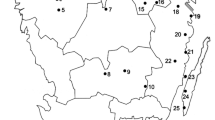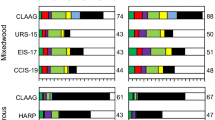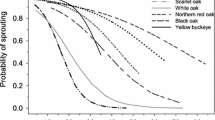Abstract
Holm-oak forests of the Montseny Massif have traditionally been exploited by selection thinning, which consists of a partial removal of standing trees and biomass. Cutting percentages within each size class indicate that this management technique represents a compromise between forest improvement and harvesting.
Sprouting is the mean regeneration process of these holm-oak stands. The mean number of living sprouts per stool is considerably higher than in other coppiced hardwood species, and decreases along the cutting-cycle according to a negative exponential function. Mean number of surviving sprouts per stool is significantly correlated with regenerative age and stool size. Death of sprouts throughout the cutting cycle is compensated by growth of surviving sprouts. Thus, the weight of living sprouts per stool increases linearly with time, and also with the basal area coppiced.
Sprouts developing within the first fifteen years of regeneration belong to a single cohort that appears during the first year after cutting. After that period of time, new sprouts appear from dormant buds, so that after 30 years of regeneration a wide range of cohorts of different ages are present.
Similar content being viewed by others
References
Buongiorno, H. & Lu, H.-C. 1990. Economic stocking and cutting-cycle in a regulated selection forest. For. Ecol. Manage. 32: 203–216.
Canadell, J., Riba, M. & Andrés, P. 1988. Biomass equations for Quercus ilex L. in the Montseny Massif, Northeastern Spain. Forestry 61: 137–147.
Cucó, M. L. 1987. Mecanismes de regeneració. In: Ecosistemes terrestres. La resposta als incendis i a d'altres pertorbacions. J. Terradas (ed.). Quaderns d'Ecologia Aplicada, 10, Diputació de Barcelona, 45–62.
Escarré, A., Gracia, C., Rodà, F. & Terradas, J. 1984. Ecología del bosque esclerófilo mediterráneo. Investigación y Ciencia 95: 68–78.
Ferm, A. & Kauppi, A. 1990. Coppicing as a means for increasing hardwood biomass production. Biomass 22: 107–121.
Ferrés, L. 1984. Biomasa, producción y mineralomasas del encinar montano de La Castanya (Montseny). Ph.D. Thesis, Autonomous University of Barcelona, Bellaterra, Barcelona.
Ferrés, L. 1985. Creixement radial i producció primària neta aèria a l'alzinar de La Castanya (Montseny, Barcelona). Orsis 1: 71–79.
Ford, E. D. & Newbould, P. J. 1970. Stand structure and dry weight production through the sweet chestnut (Castanea sativa) coppice cycle. J. Ecol. 58: 275–296.
Hara, T. 1984. A stochastic model and the moment dynamics of the growth and size distribution in plant populations. J. Theor. Biol. 109: 173–190.
Harper, J. L. 1967. A darwinian approach to plant ecology. J. Ecol. 55: 247–270.
Harper, J. L. 1977. Population biology of plants. Academic Press, London.
James, S. 1984. Lignotubers and burls—their structure, function and ecological significance in mediterranean ecosystems. Bot. Rev., 50: 226–266.
Kauppi, A., Rinne, P. & Ferm, A. 1988. Sprouting ability and significance for coppicing of dormant buds on Betula pubescens stumps. Scand. J. For. Res. 3: 343–354.
Keeley, J. E. & Zedler, P. H. 1978. Reproduction of chaparral shrubs after fire: a comparison of sprouting and seedling strategies. Am. Midl. Nat., 99: 142–161.
Koop, H. 1987. Vegetative reproduction of trees in some European natural forests. Vegetatio 72: 103–110.
Lobreaux, M. 1987. Quelques aspects de la régénération par semis, par rejets de souche et après depressage du taillis de chêne-vert (Quercus ilex L.). ENITEF Third year report, CNRS Montpellier, INRA Avignon.
Lowell, K. E., Mitchell, R. J., Johnson, P. S., Garrett, H. E., & Cox, G. S. 1987. Predicting growth and ‘success’ of coppice-regenerated oak stems. For. Sci. 33: 740–749.
MacDonald, J. E. & Powell, G. R. 1983. Relationships between stump sprouting and parent-tree diameter in sugar maple in the 1st year following clear-cutting. Can. J. For. Res. 13: 390–394.
Mayor, X. 1990. El paper dels nutrients com a factors limitants de la producció primària de l'alzinar de la conca del Torrent de la Mina (Montseny). Master Report, Autonomous University of Barcelona, Bellaterra, Barcelona.
McFadden, G. & Oliver, C. D. 1988. Three dimensional forest growth model relating tree size, tree number, and stand age: relation to previous growth models and to self-thinning. Forest. Sci. 34: 662–676.
Noble, I. R. 1984. Mortality of lignotuberous seedlings of Eucalyptus species and intense fire in montane forest. Aust. J. Ecol. 9: 47–50.
Pita, P. & Espclta, J. M. 1990. Estudio de la producción de madera en los bosques del Montseny. Publ. Univ. Autónoma Barcelona, Bellaterra, Barcelona.
Riba, M. 1987. La resposta a les estassades. In: Ecosistemes terrestres. La resposta als incendis i a d'altres pertorbacions. J. Terradas (ed.). Quaderns d'Ecologia Aplicada. 10. Diputació de Barcelona, 157–166.
Riba, M. 1991. Estudi de la regeneració per rebrotada en poblacions d'Erica arborea sotmeses a tallades. Ph.D. Thesis. Autonomous University of Barcelona, Bellaterra, Barcelona.
Romane, F., Floret, C., Galan, M., Grandianny, M., Le, Floc'h, M., Maistre, M. & Perret, P. 1988. Quelques remarques sur les taillis de chênes verts. Répartition, histoire, biomasse. Forêt Méditerranéenne 10: 131–135.
Ross, M. S., Sharik, T. L. & Smith, D. W. 1986. Oak regencration after clear felling in Southest Virginia. Forest Sci. 32: 157–159.
Tappeiner, J. C., Harrington, T. B. & Walstad, J. D. 1984, Predicting recovery of tanoak (Lithocarpus densiflorus) and pacific madrone (Arbutus menziesii) after cutting or burning. Weed. Sci. 32: 413–417.
Weiner, J., Berntson, G. M. & Thomas, S. C. 1990. Competition and growth form in a woodland annual. J. Ecol. 78: 459–469.
Williams, R. A. & McClenahen, J. R. 1984. Biomass predietion equations for seedlings, sprouts, and saplings of ten central hardwood species. Forest Sci. 30: 523–527.
Author information
Authors and Affiliations
Rights and permissions
About this article
Cite this article
Retana, J., Riba, M., Castell, C. et al. Regeneration by sprouting of holm-oak (Quercus ilex) stands exploited by selection thinning. Vegetatio 99, 355–364 (1992). https://doi.org/10.1007/BF00118242
Accepted:
Issue Date:
DOI: https://doi.org/10.1007/BF00118242




